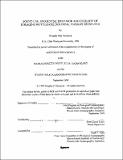Sound use, sequential behavior and ecology of foraging bottlenose dolphins, Tursiops truncatus
Author(s)
Nowacek, Douglas Paul
DownloadFull printable version (15.54Mb)
Other Contributors
Woods Hole Oceanographic Institution.
Advisor
Lloyd Tyack.
Terms of use
Metadata
Show full item recordAbstract
Odontocetes are assumed to use echolocation for navigation and foraging, but neither of these uses of biosonar has been conclusively demonstrated in free-ranging animals. Many bats are known to use echolocation throughout foraging sequences, changing the structure and timing of clicks as they progress towards prey capture. For odontocetes, however, we do not know enough about their foraging behavior to describe such sequences. To conduct detailed behavioral observations of any subject animal, the observer must be able to maintain continuous visual contact with the subject for a period commensurate with the duration of the behavior(s) of interest. Behavioral studies of cetaceans, which spend approximately 95% of their time below the water's surface, have been limited to sampling surface behavior except in special circumstances, e.g. clear-water environments, or with the use of technological tools. I addressed this limitation through development of an observation platform consisting of a remote controlled video camera suspended from a tethered airship with boat-based monitoring, adjustment, and recording of video. The system was used successfully to conduct continuous behavioral observations of bottlenose dolphins in the Sarasota Bay, FL area. This system allowed me to describe previously unreported foraging behaviors and elucidate functions for behaviors already defined but poorly understood. Dolphin foraging was modeled as a stage-structured sequence of behaviors, with the goal-directed feeding event occurring at the end of a series of search, encounter, and pursuit behaviors. The behaviors preceding a feeding event do not occur in a deterministic sequence, but are adaptive and plastic. A single-step transition analysis beginning with prey capture and receding in time has identified significant links between observed behaviors and demonstrated the stage-structured nature of dolphin foraging. Factors affecting the occurrence of specific behaviors and behavioral transitions include mesoscale habitat variation and individual preferences. The role of sound in foraging, especially echolocation, is less well understood than the behavioral component. Recent studies have explored the use of echolocation in captive odontocete foraging and presumed feeding in wild animals, but simultaneous, detailed behavioral and acoustic observations have eluded researchers. The current study used two methods to obtain acoustic data. The overhead video system includes two towed hydrophones used to record 'ambient' sounds of dolphin foraging. The recordings are of the 'ambient' sounds because the source of the sounds, i.e. animal, could not be localized. Many focal follows, however, were conducted with single animals, and from these records the timing of echolocation and other sounds relative to the foraging sequence could be examined. The 'ambient' recordings revealed that single animals are much more vocal than animals in groups, both overall and during foraging. When not foraging, single animals vocalized at a rate similar to the per animal rate in groups of>=2 animals. For single foraging animals, the use of different sound types varies significantly by the habitat in which the animal is foraging. These patterns of use coupled with the characteristics of the different sound types suggest specific functions for each. The presence of multiple animals in a foraging group apparently reduces the need to vocalize, and potential reasons for this pattern are discussed. In addition, the increased vocal activity of single foraging animals lends support to specific hypotheses of sound use in bottlenose dolphins and odontocetes in general. The second acoustic data collection method records sounds known to be from a specific animal. An acoustic recording tag was developed that records all sounds produced by an animal including every echolocation click. The tag also includes an acoustic sampling interval controller and a sensor suite that measures pitch, roll, heading, and surfacing events. While no foraging events occurred while an animal was wearing an acoustic data logger, the rates of echolocation and whistling during different activities, e.g. traveling, were measured.
Description
Thesis (Ph. D.)--Joint Program in Biological Oceanography (Massachusetts Institute of Technology, Dept. of Biology; and the Woods Hole Oceanographic Institution), 1999. Includes bibliographical references.
Date issued
1999Department
Joint Program in Biological Oceanography.; Woods Hole Oceanographic Institution; Massachusetts Institute of Technology. Department of BiologyPublisher
Massachusetts Institute of Technology
Keywords
Joint Program in Biological Oceanography., Biology., Woods Hole Oceanographic Institution.